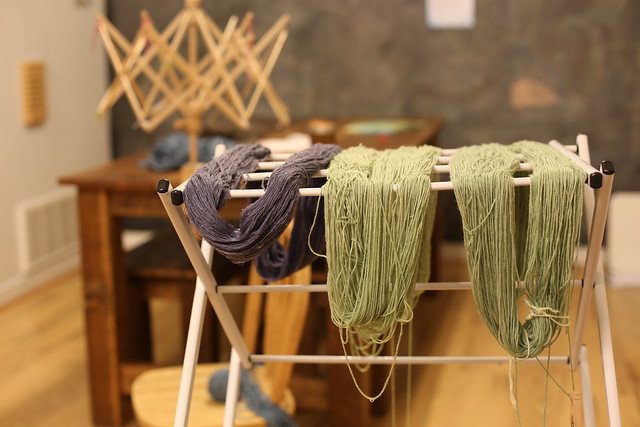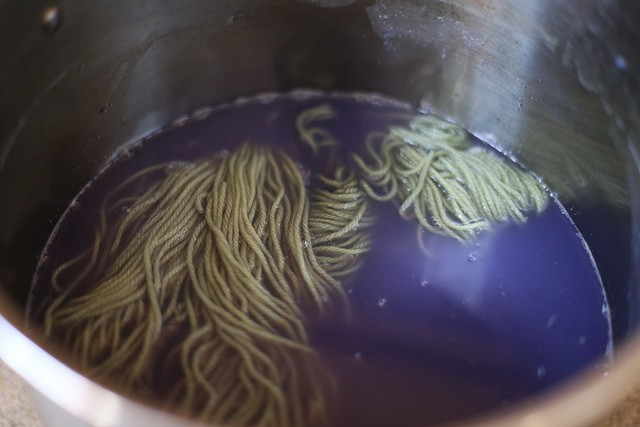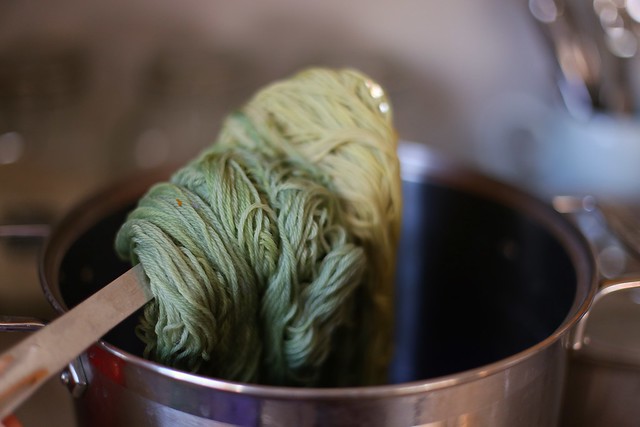







I have had a few requests to share how K and I have been dyeing our yarn with natural dyes so I thought I would try my best to share our
We start out by applying a mordant to our yarn. We typically do about 8 ounces of yarn at a time which works out to a mordant solution of 2 tbsp. alum and 2 tsp. cream of tartar in a pot of water. We simmer the yarn in the solution for about twenty minutes or so and then move it into the dye bath.
For the dockseed dyed yarn shown above and in last Wednesday's post we did the following:
We simmered about 4 ounces of chopped dockseed stalks we collected back in Oregon (I have a jar of the seeds leftover to make crackers with and perhaps try planting in our garden) in a large pot on the stovetop for about an hour and then let the dye bath sit overnight. The next day we strained out the stalks and brought the pot back to a simmer. We added our premordanted (and still wet) yarn to the pot and let it continue to simmer. We were supposed to leave it in for an hour but I took ours out after about thirty five minutes or so. I was afraid it would become a dark brown and I was hoping for a warm, light nutmeg shade. We took the yarn out with some tongs and let it cool down to room temperature. Then we rinsed it in lukewarm water and hung it to dry.
The black bean dyed yarn was a bit more time consuming as it involves soaking for longer periods and not simmering on the stove top. We again planned on dyeing about 8 ounces of yarn total. To do so we poured eight cups of dried black beans in our largest pot and filled it with warm water. We let it soak for forty eight hours (word of caution - this dye bath gets smelly so a laundry room, basement or garage would be a good place to store it while it soaks). Then we strained out the beans and added our premordanted yarn to the dye bath. This time we tried dyeing a couple of skeins of wool yarn and one skein of pure silk yarn (K really has her heart set on knitting the baby a silk hat). I was told to let the yarn sit for forty eight hours but, as usual, we couldn't wait that long. After about twenty four hours we took our yarn out. We rinsed it with lukewarm water (really, really well to remove any smell) and hung it up to dry. You can see in the photographs above that the silk took the dye differently than the wool. The wool is a brighter blue while the silk is almost purple/blue.
Seeing our pretty blue yarn gave K and I an idea. She had been wanting to make a green dye so we thought we would experiment with the dye baths we already had to create our own green by over-dyeing. First we grabbed eight ounces of wool yarn and applied our mordant solution. Then we got out our leftover marigold dye bath, poured it into a pot, added the yarn and simmered it for thirty minutes. We took the marigold dyed yarn out, let it cool and rinsed it with lukewarm water. Then we immediately placed one of the skeins into our leftover black bean dye bath (not on the stove top!). I only did one skein at first because I didn't know how our experiment would turn out and I was a bit attached to the pale yellow yarn we made. At first the yarn looked like it was going to turn an unattractive shade of brown but after about an hour it turned green! Happy with our little experiment, I then added the second skein of marigold yarn. I didn't keep track of exactly how long we left the skeins in, I just kept checking on them throughout the day until I thought they were just the shade of green we were hoping for. I would guess they spent maybe four or five hours total in the black bean dye bath. We rinsed them in lukewarm water and hung them to dry. They turned into this beautiful spring green color. I wasn't able to capture it with my camera today but I will try again this week so you can see what I mean.
I warn you, dyeing yarn with materials found in your backyard or garden is highly addictive. I can't sleep some nights thinking about what we can dye with next. This week I think we'll try using our black walnuts we collected at Walnut Hill (Portland Waldorf School).


 Logging you in...
Logging you in...
Melissa · 507 weeks ago
Zena · 507 weeks ago
FrontierDreams 111p · 506 weeks ago
fifthlampdown 31p · 507 weeks ago
FrontierDreams 111p · 506 weeks ago
cariemay 52p · 507 weeks ago
Christine Schreier · 507 weeks ago
Hugs, Christine
FrontierDreams 111p · 506 weeks ago
Kimberly · 507 weeks ago
FrontierDreams 111p · 506 weeks ago
archer1955 21p · 507 weeks ago
FrontierDreams 111p · 506 weeks ago
archer1955 21p · 506 weeks ago